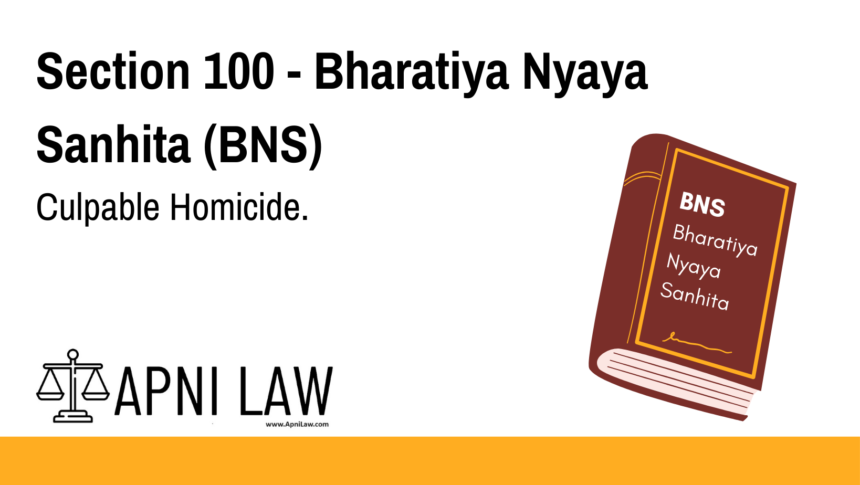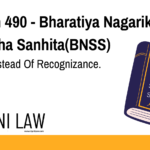Code: Exact Provision of Section 100 BNS
Section 100 – Culpable Homicide
Whoever causes death by doing an act with the intention of causing death,
or with the intention of causing such bodily injury as is likely to cause death, or with the
knowledge that he is likely by such act to cause death, commits the offence of culpable
homicide.
Illustrations.
(a) A lays sticks and turf over a pit, with the intention of thereby causing death, or with
the knowledge that death is likely to be thereby caused. Z, believing the ground to be firm,
treads on it, falls in and is killed. A has committed the offence of culpable homicide.
(b) A knows Z to be behind a bush. B does not know it. A, intending to cause, or
knowing it to be likely to cause Z’s death, induces B to fire at the bush. B fires and kills Z.
Here B may be guilty of no offence; but A has committed the offence of culpable homicide.
(c) A, by shooting at a fowl with intent to kill and steal it, kills B, who is behind a bush;
A not knowing that he was there. Here, although A was doing an unlawful act, he was not
guilty of culpable homicide, as he did not intend to kill B, or to cause death by doing an act
that he knew was likely to cause death.
Explanation 1.—A person who causes bodily injury to another who is labouring
under a disorder, disease or bodily infirmity, and thereby accelerates the death of that other,
shall be deemed to have caused his death.
Explanation 2.—Where death is caused by bodily injury, the person who causes such
bodily injury shall be deemed to have caused the death, although by resorting to proper
remedies and skilful treatment the death might have been prevented.
Explanation 3.—The causing of the death of a child in the mother’s womb is not
homicide. But it may amount to culpable homicide to cause the death of a living child, if any
part of that child has been brought forth, though the child may not have breathed or been
completely born.
Explanation of Section 100 BNS
What is Culpable Homicide?
Culpable homicide refers to an act that results in death due to:
- Intention to cause death.
- Intention to cause bodily harm that is likely to cause death.
- Knowledge that the act could cause death.
This provision ensures that intentional and reckless killings are punished, while distinguishing them from accidents.
Difference Between Culpable Homicide and Murder
- Murder (Section 101 BNS) requires greater intent and premeditation.
- Culpable Homicide (Section 100 BNS) includes cases where intent or knowledge exists but may be less severe than murder.
Illustration: Real-Life Example
🚨 Case 1: Death Caused by Reckless Action
A bus driver, knowing that his reckless speed might cause death, crashes and kills a pedestrian. He knew the risk but ignored it, making it culpable homicide.
🔫 Case 2: Death from Unintended Injury
A man slaps an elderly person, who suffers a fatal heart attack due to a pre-existing condition. Since the act accelerated death, it qualifies as culpable homicide.
Common Questions and Answers
1. What is the punishment for culpable homicide under BNS?
The punishment varies based on the severity of the act. It can range from 10 years to life imprisonment along with a fine.
2. Can accidental death be considered culpable homicide?
No, accidental deaths are not culpable homicide unless there was prior knowledge that the act could likely cause death.
3. Is the death of an unborn child considered homicide?
No, but if any part of the child is brought forth alive, and then killed, it may amount to culpable homicide.
4. Can medical negligence lead to culpable homicide charges?
Yes, if a doctor knowingly ignores life-saving treatment, causing death, it may amount to culpable homicide.
Related Sections in Bharatiya Nyaya Sanhita (BNS)
🔹 Section 101 – Murder
🔹 Section 102 – Death by Negligence
Conclusion
Section 100 of Bharatiya Nyaya Sanhita (BNS), 2023, ensures that intentional and reckless killings are punished appropriately. It provides a clear distinction between culpable homicide and murder, ensuring justice is served fairly.
For more legal insights, visit ApniLaw today! 🚀











